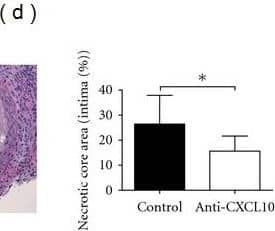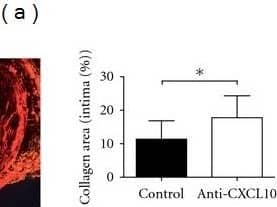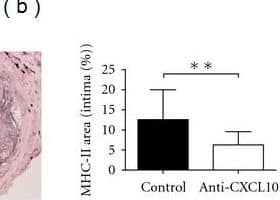Mouse CXCL10/IP-10/CRG-2 Antibody Summary
Ile22-Pro98
Accession # P17515
Customers also Viewed
Applications
Mouse CXCL10/IP-10/CRG-2 Sandwich Immunoassay
Please Note: Optimal dilutions should be determined by each laboratory for each application. General Protocols are available in the Technical Information section on our website.
Scientific Data
 View Larger
View Larger
Chemotaxis Induced by CXCL10/CRG‑2 and Neutralization by Mouse CXCL10/CRG‑2 Antibody. Recombinant Mouse CXCL10/CRG‑2 (Catalog # 466-CR) chemoattracts the BaF3 mouse pro‑B cell line transfected with human CXCR3 in a dose-dependent manner (orange line). The amount of cells that migrated through to the lower chemotaxis chamber was measured by Resazurin (Catalog # AR002). Chemotaxis elicited by Recombinant Mouse CXCL10/CRG‑2 (0.5 µg/mL) is neutralized (green line) by increasing concentrations of Mouse CXCL10/CRG‑2 Monoclonal Antibody (Catalog # MAB466). The ND50 is typically 10-40 µg/mL.
 View Larger
View Larger
Detection of Mouse CXCL10/IP-10/CRG-2 by Immunohistochemistry Anti-CXCL10 treatment in atherosclerosis susceptible mice results in a change into a more stable lesion phenotype. A flow-altering device around the common carotid artery induced atherosclerosis in ApoE−/− mice. From week 1 to 4 of lesion development, a bioactivity-neutralizing anti-CXCL10 antibody was injected. After 9 weeks, lesions were compared to untreated controls by histology. The pictures show representative histological sections of treated and control mice. All photographs have been made with the same magnification (100x). Scale bars are provided in (e) and represent 100 μm. Data in bar diagrams are the mean values ± SD of at least 8 sections from at least 10 different animals per group. CXCL10 inhibition resulted in a more stable morphology evidenced by unchanged amounts of lesion macrophages (a), increased amounts of collagen (b), decreased macrophage activation (c), increased numbers of SMC (d), and reduced necrotic core size (e). *P < 0.05, **P < 0.01. MHC-II: Major Histocompatibility Complex Class II, SMC: smooth muscle cell. Image collected and cropped by CiteAb from the following open publication (https://pubmed.ncbi.nlm.nih.gov/22164344), licensed under a CC-BY license. Not internally tested by R&D Systems.
 View Larger
View Larger
Detection of Mouse CXCL10/IP-10/CRG-2 by Immunohistochemistry Anti-CXCL10 treatment in atherosclerosis susceptible mice results in a change into a more stable lesion phenotype. A flow-altering device around the common carotid artery induced atherosclerosis in ApoE−/− mice. From week 1 to 4 of lesion development, a bioactivity-neutralizing anti-CXCL10 antibody was injected. After 9 weeks, lesions were compared to untreated controls by histology. The pictures show representative histological sections of treated and control mice. All photographs have been made with the same magnification (100x). Scale bars are provided in (e) and represent 100 μm. Data in bar diagrams are the mean values ± SD of at least 8 sections from at least 10 different animals per group. CXCL10 inhibition resulted in a more stable morphology evidenced by unchanged amounts of lesion macrophages (a), increased amounts of collagen (b), decreased macrophage activation (c), increased numbers of SMC (d), and reduced necrotic core size (e). *P < 0.05, **P < 0.01. MHC-II: Major Histocompatibility Complex Class II, SMC: smooth muscle cell. Image collected and cropped by CiteAb from the following open publication (https://pubmed.ncbi.nlm.nih.gov/22164344), licensed under a CC-BY license. Not internally tested by R&D Systems.
 View Larger
View Larger
Detection of Mouse CXCL10/IP-10/CRG-2 by Immunohistochemistry Anti-CXCL10 treatment in atherosclerosis susceptible mice results in a change into a more stable lesion phenotype. A flow-altering device around the common carotid artery induced atherosclerosis in ApoE−/− mice. From week 1 to 4 of lesion development, a bioactivity-neutralizing anti-CXCL10 antibody was injected. After 9 weeks, lesions were compared to untreated controls by histology. The pictures show representative histological sections of treated and control mice. All photographs have been made with the same magnification (100x). Scale bars are provided in (e) and represent 100 μm. Data in bar diagrams are the mean values ± SD of at least 8 sections from at least 10 different animals per group. CXCL10 inhibition resulted in a more stable morphology evidenced by unchanged amounts of lesion macrophages (a), increased amounts of collagen (b), decreased macrophage activation (c), increased numbers of SMC (d), and reduced necrotic core size (e). *P < 0.05, **P < 0.01. MHC-II: Major Histocompatibility Complex Class II, SMC: smooth muscle cell. Image collected and cropped by CiteAb from the following open publication (https://pubmed.ncbi.nlm.nih.gov/22164344), licensed under a CC-BY license. Not internally tested by R&D Systems.
Preparation and Storage
- 12 months from date of receipt, -20 to -70 °C as supplied.
- 1 month, 2 to 8 °C under sterile conditions after reconstitution.
- 6 months, -20 to -70 °C under sterile conditions after reconstitution.
Background: CXCL10/IP-10/CRG-2
The gene for CRG-2, a mouse homolog of human IP-10, was originally identified as an immediate early gene induced in response to macrophage activation. It has since been shown that CRG-2 mRNA is induced by alpha / beta / gamma -interferons and by lipopolysaccharide in macrophages, astrocytes and microglia. Human IP-10 was also shown to be expressed in activated T-lymphocytes, splenocytes, keratinocytes, osteoblasts, astrocytes, and smooth muscle cells. Mouse CRG-2 cDNA encodes a 98 amino acid (aa) residue precursor protein with a 21 aa residue signal peptide that is cleaved to form the 77 aa residue secreted mature protein. Mature CRG-2 shares approximately 67% amino acid sequence identity with human IP-10. The amino acid sequence of CRG-2 identified the protein as a member of the chemokine alpha subfamily that lacks the ELR domain. CRG-2 has been shown to be a chemoattractant for activated T-lymphocytes. Recently, human IP-10 has also been reported to be a potent inhibitor of angiogenesis and to display a potent thymus-dependent anti-tumor effect. A chemokine receptor specific for IP-10 and MIG (CXCR3) has been cloned and shown to be highly expressed in IL-2-activated T-lymphocytes.
- Loetscher, M. et al. (1996) J. Exp. Med. 184:963.
- Vanguri, P. (1996) J. Neuroimmunol. 56:35.
- Sgadari, C. et al. (1996) Blood, 87:3877.
Product Datasheets
Citations for Mouse CXCL10/IP-10/CRG-2 Antibody
R&D Systems personnel manually curate a database that contains references using R&D Systems products. The data collected includes not only links to publications in PubMed, but also provides information about sample types, species, and experimental conditions.
21
Citations: Showing 1 - 10
Filter your results:
Filter by:
-
MLKL signaling regulates macrophage polarization in acute pancreatitis through CXCL10
Authors: C Peng, G Tu, J Wang, Y Wang, P Wu, L Yu, Z Li, X Yu
Cell Death & Disease, 2023-02-24;14(2):155.
Species: Mouse
Sample Types: In Vivo
Applications: Neutralization -
Lacticaseibacillus paracasei sh2020 induced antitumor immunity and synergized with anti-programmed cell death 1 to reduce tumor burden in mice
Authors: Shi-Long Zhang, Bing Han, Yu-Qin Mao, Zheng-Yan Zhang, Zhan-Ming Li, Chao-Yue Kong et al.
Gut Microbes
-
MYC inhibition reprograms tumor immune microenvironment by recruiting T lymphocytes and activating the CD40/CD40L system in osteosarcoma
Authors: Kuo Jiang, Qianfeng Zhang, Yong Fan, Jia Li, Jitao Zhang, Wentao Wang et al.
Cell Death Discovery
-
The selective STING inhibitor H-151 preserves myocardial function and ameliorates cardiac fibrosis in murine myocardial infarction
Authors: S Hu, Y Gao, R Gao, Y Wang, Y Qu, J Yang, X Wei, F Zhang, J Ge
International immunopharmacology, 2022-03-09;107(0):108658.
Species: Mouse
Sample Types: Cell Culture Supernates
Applications: Neutralization -
Chronic kidney disease mediates cardiac dysfunction associated with increased resident cardiac macrophages
Authors: MA Mawhin, RG Bright, JD Fourre, EI Vloumidi, J Tomlinson, A Sardini, CD Pusey, KJ Woollard
Bmc Nephrology, 2022-01-28;23(1):47.
Species: Mouse
Sample Types: In Vivo
Applications: In Vivo -
C-X-C Chemokines Influence Intraocular Inflammation During Bacillus Endophthalmitis
Authors: MH Mursalin, PS Coburn, FC Miller, ET Livingston, R Astley, MC Callegan
Investigative Ophthalmology & Visual Science, 2021-11-01;62(14):14.
Species: Mouse
Sample Types: In Vivo
Applications: Neutralization -
CXCL10/CXCR3 signaling contributes to an inflammatory microenvironment and its blockade enhances progression of murine pancreatic precancerous lesions
Authors: Veethika Pandey, Alicia Fleming-Martinez, Ligia Bastea, Heike R Doeppler, Jillian Eisenhauer, Tam Le et al.
eLife
-
circFAT1 Promotes Cancer Stemness and Immune Evasion by Promoting STAT3 Activation
Authors: Lingfei Jia, Yilun Wang, Cun‐Yu Wang
Advanced Science
-
Cytotoxic T cells swarm by homotypic chemokine signalling
Authors: Jorge Luis Galeano Niño, Sophie V Pageon, Szun S Tay, Feyza Colakoglu, Daryan Kempe, Jack Hywood et al.
eLife
-
CDK4/6 inhibition promotes immune infiltration in ovarian cancer and synergizes with PD-1 blockade in a B cell-dependent manner
Authors: QF Zhang, J Li, K Jiang, R Wang, JL Ge, H Yang, SJ Liu, LT Jia, L Wang, BL Chen
Theranostics, 2020-08-25;10(23):10619-10633.
Species: Mouse
Sample Types: Whole Cells
Applications: Migration Assay -
Early growth response 1 deficiency protects host against Pseudomonas aeruginosa lung infection
Authors: Z Pang, R Raudonis, C McCormick, Z Cheng
Infect. Immun., 2019-12-17;0(0):.
Species: Mouse
Sample Types: BALF
Applications: ELISA Capture -
Translational repression of Ccl5 and Cxcl10 by 4E-BP1 and 4E-BP2 restrains the ability of mouse macrophages to induce migration of activated T�cells
Authors: M William, LP Leroux, V Chaparro, TE Graber, T Alain, M Jaramillo
Eur. J. Immunol., 2019-05-06;0(0):.
Species: Mouse
Sample Types: Whole Cells
Applications: Neutralization -
Nitrosporeusine analogue ameliorates Chandipura virus induced inflammatory response in CNS via NF?b inactivation in microglia
Authors: AK Verma, TS Waghmare, GR Jachak, SC Philkhana, DS Reddy, A Basu
PLoS Negl Trop Dis, 2018-07-12;12(7):e0006648.
Species: Mouse
Sample Types: Cell Culture Supernates
Applications: ELISA Development (Capture) -
IL-33 Attenuates Sepsis by Inhibiting IL-17 Receptor Signaling through Upregulation of SOCS3
Authors: R Lv, J Zhao, M Lei, D Xiao, Y Yu, J Xie
Cell. Physiol. Biochem., 2017-08-09;42(5):1961-1972.
Species: Mouse
Sample Types: Serum
Applications: ELISA Development (Capture) -
Monocyte- and Neutrophil-Derived CXCL10 Impairs Efficient Control of Blood-Stage Malaria Infection and Promotes Severe Disease.
Authors: Ioannidis L, Nie C, Ly A, Ryg-Cornejo V, Chiu C, Hansen D
J Immunol, 2015-12-30;196(3):1227-38.
Species: Mouse
Sample Types: Tissue Homogenates
Applications: ELISA Development (Capture) -
Dipeptidylpeptidase 4 inhibition enhances lymphocyte trafficking, improving both naturally occurring tumor immunity and immunotherapy.
Authors: Barreira da Silva R, Laird M, Yatim N, Fiette L, Ingersoll M, Albert M
Nat Immunol, 2015-06-15;16(8):850-8.
Species: Mouse
Sample Types: In Vivo, Plasma
Applications: ELISA Development (Capture), Neutralization -
The Early Activation Marker CD69 Regulates the Expression of Chemokines and CD4 T Cell Accumulation in Intestine
Authors: Katarina Radulovic, Valerio Rossini, Calin Manta, Karlheinz Holzmann, Hans A. Kestler, Jan Hendrik Niess
PLoS ONE
-
Atherosclerotic Plaque Stability Is Affected by the Chemokine CXCL10 in Both Mice and Humans
Authors: Dolf Segers, Jonathan A. Lipton, Pieter J. M. Leenen, Caroline Cheng, Dennie Tempel, Gerard Pasterkamp et al.
International Journal of Inflammation
-
T Cell-, Interleukin-12-, and Gamma Interferon-Driven Viral Clearance in Measles Virus-Infected Brain Tissue
Authors: Samantha R. Stubblefield Park, Mi Widness, Alan D. Levine, Catherine E. Patterson
Journal of Virology
-
Tumor-infiltrating myeloid-derived suppressor cells are pleiotropic-inflamed monocytes/macrophages that bear M1- and M2-type characteristics.
Authors: Umemura N, Saio M, Suwa T, Kitoh Y, Bai J, Nonaka K, Ouyang GF, Okada M, Balazs M, Adany R, Shibata T, Takami T
J. Leukoc. Biol., 2008-02-19;83(5):1136-44.
Species: Mouse
Sample Types: Whole Cells
Applications: Flow Cytometry -
CXC Motif Chemokine 10 Impairs Autophagy and Autolysosome Formation in Non-alcoholic Steatohepatitis
Authors: Zhang X, Wu WK, Xu W et al.
Theranostics.
FAQs
No product specific FAQs exist for this product, however you may
View all Antibody FAQsIsotype Controls
Reconstitution Buffers
Secondary Antibodies
Reviews for Mouse CXCL10/IP-10/CRG-2 Antibody
Average Rating: 5 (Based on 1 Review)
Have you used Mouse CXCL10/IP-10/CRG-2 Antibody?
Submit a review and receive an Amazon gift card.
$25/€18/£15/$25CAN/¥75 Yuan/¥2500 Yen for a review with an image
$10/€7/£6/$10 CAD/¥70 Yuan/¥1110 Yen for a review without an image
Filter by:





















